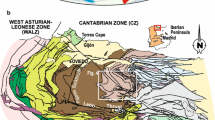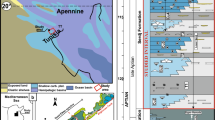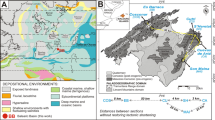Summary
Factors controlling grain composition and depositional environments of upper Cenomanian—Santonian limestones of Sinai are discussed. The mainly shallow-water, inner-platform setting investigated is subdivided into five major facies belts, each represented by several microfacies types (MFTs). Their lateral distribution patterns and their composition underline aclear relation between depositional environment and platform position. The facies belts include sandstones and quartzose packstones of siliciclastic shorefaces, mudstones and bioclastic wackestones of restricted lagoons, shallow-subtidal packstones with diverse benthic foraminifera and calcareous algae, bioclastic and/or oolitic grainstones of inner-platform shoals, and wackestones of deep open-marine environments.
The microfacies distribution patterns of the Cenomanian-Santonian strata are evaluated with respect to local and regional large-scale environmental changes. While protected shallow-subtidal environments with only subordinate ooids and oncoids prevail during the late Cenomanian, high-energy oolithic shoals and carbonate sands occur locally during the middle and late Turonian. They were probably related to a change of the platform morphology and a reorganisation of the platform after a late Cenomanian drowning. In the Coniacian-Santonian, the lack of ooids, oncoids, and the decrease of calcareous algae versus an increase in siliciclastics indicate a shift to lower water temperature and to a more humid climate. Especially in the Turonian, the interplay between sea-level changes, accommodation, hydrodynamics, and siliciclastic input is reflected by lithofacies and biofacies interrelation-ships that are elaborated within individual systems tracts. In particular, increasing accommodation intensified circulation and wave-agitation and controlled the distribution of high-energy environments of the middle and upper Turonian trans-gressive systems tracts. During highstands protected innerplatform environments prevailed.
Similar content being viewed by others
References
Abdel-Kireem, M.R., Schrank, E., Samir, A.M. and Ibrahim, M.I.A. (1996): Cretaceous palaeoecology, palaeogeography and palaeoclimatology of the northern Western Desert, Egypt.— J. Afric. Earth Sci.,22, 93–112, Amsterdam.
Abed, A.M. and Amireh, B.S. (1999): Sedimentology, geochemistry, economic potential and palaeogeography of an Upper Cretaceous phosphorite belt in southeastern desert of Jordan.—Cretaceeus Res.20, 119–133, London.
Ahmed, S.M. (1995): Facies characteristics of the Upper Cretaceous exposures, Taba area, Sinai, Egypt.—Egypt. J. Geol.,39, 159–178, Cairo.
Almogi-Labin, A., Bein, A. and Sass, E. (1993): Late Cretaceous upwelling systems along the southern Tethys margin (Israel): interrelationship between productivity, bottom water environments, and organic matter preservation.—Paleoceanography,8, 671–690, Washington, DC.
Arthur, M.A., Schlanger, S.O. and Jenkyns, H.C. (1987): The Cenomanian-Turonian Oceanic Anoxic Event, II. Palaeocenographic controls on organic-matter production and preservation— In: Brooks, J. and Fleets, A.J. (eds.): Marine petroleum source rocks.—Geol. Soc. London Spec. Publ.,26, 401–420, Oxford (Blackwell).
Bachmann, M. and Kuss, J. (1998): The Middle Cretaceous carbonate ramp of the northern Sinai: sequence stratigraphy and facies distribution.—In: Wright, V.P. and Burchette, T.P. (eds.): Carbonate Ramps.—Geol. Soc. London Spec. Publ.,149, 253–280, Oxford (Blackwell).
Barattolo, F. (1991): Mesozoic and Cenozoic marine benthic calcareous algae with particular regard to Mesozoic dasycladaceans.—In: Riding, R. (ed.): Calcareous algae and stromatolites.—504–540, Berlin, (Springer).
Bartov, Y. and Steinitz, G. (1977): The Judea and Mount Scopus groups in the Negev and Sinai with trend surface analysis of the thickness data.—Israel J. Earth-Sci.,26, 119–148, Jerusalem.
Bartov, Y., Lewy, Z., Steinitz, G. and Zak, I. (1980): Mesozoic and Tertiary stratigraphy, paleogeography and structural history of the Gebel Areif en Naqa area, eastern Sinai.—Israel J. Earth-Sci.,29, 114–139, Jerusalem.
Bassoullet, J.P., Bernier, P., Deloffre, R., Gènot, P., Poncet, J. and Roux, A. (1983): Udoteacea.—Bull. Centres Rech. Explor.— Prod. Elf Aquitaine,7, 449–621, Pau.
Bauer, J., Marzouk, A.M., Steuber, T. and Kuss, J. (2001): Lithostratigraphy and biostratigraphy of the Cenomanian— Santonian strata of Sinai, Egypt.—Cretaceous Res.,22, 497–526, London.
Bauer, J. (2002): Late Cenomanian-Santonian carbonate platform evolution of Sinai (Egypt): stratigraphy, facies, and sequence architecture.—Berichte, Fachbereich Geowissenschaften, Universität Bremen,191, 178 p., Breman.
Bosence, D.W.J. (1983): Description and classification of rhodoliths (rhodoids, rhodolites).—In: Peryt, T. (ed.): Coated grains.—217–224, Berlin (Springer).
Bosworth, W., Guiraud, R. and Kessler, L.G. (1999): Late Cretaceous (ca. 84 Ma) compressive deformation of the stable platform of northeast Africa (Egypt): far-field stress effects of the “Santonian event” and origin of the Syrian arc deformation belt.—Geology,27, 633–636, Boulder.
Brett, C.E. (1998): Sequence stratigraphy, paleoecology, and evolution: biotic clues and responses to sea-level fluctuations.— Palaios,13, 241–262, Tulsa.
Buchbinder, B., Benjamini, C. and Lipson-Benitah, S. (2000): Sequence development of Late Cenomanian—Turonian carbonate ramps platforms and basins in Israel.—Cretaceous Res.,21, 813–843, London.
Burchette, T.P. and Wright, V.P. (1992): Carbonate ramp depositional systems.—Sediment. Geol.,79, 3–57, Amsterdam.
Carannante, G., Ruberti, D. and Sirna, M. (2000): Upper Cretaceous ramp limestones from Sorrento Peninsula (southern Apennines, Italy): micro- and macrofossil associations and their significance in depositional sequences.—Sedim. Geol.,132, 89–123, Amsterdam.
Carannante, G., Graziano, R., Rubertti D. and Simone, L. (1997): Upper Cretaceous temperatute-type open shelves from northern (Sardinia) and southern (Apennines-Apulia) Mesozoic Tethyan margins—In: James, N.P. and Clarke, J.A.D. (eds.): Cool-water carbonates.—(SEPM) Soc. Econ. Paleontol. Mineral. Spec. Publ.,56; 309–325, Tulsa.
Carannante, G., Cherchi, A. and Simone, L. (1995): Chlorozoan versus foramol lithofacies in Upper Cretaceous rudist limestones.—In: Philip, J. and Skelton, P.W. (eds.): Palaeo-environmental models for the benthic associations of Cretaceous carbonate platforms in the Tethyan realm.—Palaeogeogr., Palaeoclimatol., Palaeoecol.,119, 137–154, Amsterdam.
Chérif, O.H., Al-Rifaiy, I.A., Al-Afifi, F.I. and Orabi, O.H. (1989): Foraminiferal biostratigraphy and paleoecology of some Cenomanian-Turonian exposures in west-central Sinai, (Egypt).—Rev. Micropaléont.,31, 243–262, Paris
D'Argenio, B., Ferreri, V., Raspini, A., Amodio, S. and Buonocunto, F.P. (1999): Cyclostratigraphy of a carbonate platform as a tool for high-precision correlation.—Tectonophysics,315, 357–384, Amsterdam.
Di Stefano, P. and Ruberti, D. (2000): Cenomanian rudist-dominated shelf-margin limestones from the Panormide carbonate platform (Sicily, Italy): facies analysis and sequence stratigraphy.— Facies,42, 133–160.
Dunham, R.J. (1962): Classification of carbonate rocks according to depositional texture.—In: Ham, W.E. (ed.): Classification of carbonate rocks.—Amer. Assoc. Petrol. Geol. Mem.,1, 108–121, Tulsa.
El-Azabi, M.H. and El-Araby, A. (1996): Depositional facies and palaeoenvironments of the Albian-Cenomanian sediments in Gabal El-Minshera, north central Sinai, Egypt.—Geol. Soc. Egypt Spec. Publ.,2, 151–198, Cairo.
El-Naggar, Z.R. and Al-Rifaiy, I.A. (1973): Stratigraphy and microfacies of type Magwa Formation of Kuwai, Arabia: Part 2: Mishrif Limestone Member. Amer. Assoc. Petrol. Geol. Bull.,57, 2263–2279, Tulsa.
Elliot, G.F. (1991): Dasycladalean algae of the Palaeozoic and Mesozoic.—In: Riding, R. (ed.): Calcareous algae and stromatolites.—125–130, Berlin (Springer).
Embry, A.F. and Kloven, S.E. (1972): Absolute water depth limits of late Devonian paleoecological zones.—Geologische Rundschau,61, 672–686, Stuttgart
Eshet, Y., Almogi-Labin, A. and Bein, A. (1994): Dinoflagellate cysts, paleoproductivity and upwelling systems: A Late Cretaceous example from Israel.—Marine Micropaleont.,23, 231–240, Amsterdam.
Eweda, S. and El-Sorogy, A.S. (1999): Stratigraphy and facies development of the Upper Cretaceous.—Lower Tertiary succession in Wadi Feiran area, southwestern Sinai, Egypt..—N. Jb. Geol. Paläontol. Abh.,211, 263–289, Stuttgart.
Flügel, E. (1982): Microfacies analysis of limestones.—633 p., Berlin (Springer).
Frakes, L.A., Francis, J.E. and Syktus, J.I. (1992): Climate modes of the Phanerozoic: the history of the earth's climate over the past 600 million years.—274 p. Cambridge (Cambridge University Press).
Glenn, C.R. (1990): Depositional sequences of the Duwi, Sibâiya and phosphate formations, Egypt: phosphogenesis and glauconitization in a Late Cretaceous epeiric sea.—In: Notholt, A.J.G. and Jarvis, I. (eds.). Phosphorite research and development.— Geol. Soc. London Spec. Publ.,52, 205–222, Oxford (Blackwell).
Guiraud, R. and Bosworth, W. (1997): Senonian basin inversion and rejuvenation of rifting in Africa and Arabia: synthesis and implications to plate-scale tectonics.—Tectonophysics,282, 39–82, Amsterdam.
Hamaoui, M. and Saint-Marc P. (1970): Microfaunes et microfaciès du Cénomanien du proche-orient.—Bull. Centre Rech. Pau-SNPA,4, 257–352, Pau.
Handford, C.R. and Loucks, R.G. (1993): Carbonate depositional sequences and systems tracts—responses of carbonate platforms to relative sea-level changes.—In: Loucks, R.G. and Sarg, J.F. (eds.): Carbonate sequence stratigraphy-recent events and applications.—Amer. Assoc. Petrol. Geol. Mem.,57, 3–41, Tulsa.
Hardenbol, J., Thierry, J., Farley, M.B., Jacquin, T., De Graciansky, P.-C. and Vail, P.R. (1998): Chart 5, Mesozoic and Cenozoic sequence chronostratigraphic framework of European basin.— In: De Graciansky, P.-C., Hardenbol, J., Jacquin, T. and Vail, P.R. (eds.): Mesozoic and Cenozoic sequence stratigraphy of European basins.—(SEPM) Soc. Econ. Paleontol. Mineral. Spec. Publ.,60, Tulsa.
Harris, P.M., Frost, S.H., Seiglie, G.A. and Schneidermann, N. (1984): Regional unconformities and depositional cycles, Cretaceous of the Arabian Peninsula.—In: Schlee, J.S. (ed.): Interregional unconformities and hydrocarbon accumulation.— Amer. Assoc. Petrol. Geol. Mem.,36, 67–80, Tulsa.
Hart, M.B. (1999): The evolution and biodiversity of Cretaceous planktonic foraminiferida.—Geobios,32, 247–255, Lyon.
Heimhofer, U. (1999). Mikrofazies, Zyklostratigraphie und Diagenese zweier Profile der oberturonen Wata-Formation (E'Sinaihalbinsel/Ägypten).— Unpublished Diploma thesis, Institute for Geology and Mineralogy, Erlangen-Nürnberg University.
Hunt, D. and Tucker, M.E. (1993): Sequence stratigraphy of carbonate shelves with an example from the mid-Cretaceous (Urgonian) of southeast France.—In: Posamentier, H.W., Summerhayes, C.P., Haq, B.U. and Allen, G.P. (eds.): Sequence stratigraphy and facies associations.—Int. Assoc. Sedimentol. (IAS) Spec. Publ.,18, 307–341, Oxford (Blackwell).
Ibrahim, M.I.A. and Abdel-Kireem, M.R. (1997): Late Cretaceous palynofloras and foraminifera from Ain El-Wadi area, Farafra Oasis, Egypt.—Cretaceous Res.,18, 633–660, London.
James, N.P. and Kendall, A.C. (1992): Introduction to carbonate and evaporite facies models.—In: Walker, R.G. (ed.): Facies models: response to seal-level changes.—265–275, Geological Association of Canada.
Jarvis, I., Carson, G.A., Cooper, M.K.E., Hart, M.B., Leary, P.N., Tocher, B.A., Horne, D. and Rosenfeld, A. (1988): Microfossil assemblages and the Cenomanian-Turonian (late Cretaceous) Oceanic Anoxic Event.—Cretaceous Res.,9, 3–103, London.
Kassab, A.S. (1996): Cenomanian-Turonian boundary in the Gulf of suez region: towards an inter-regional correlation, based on ammonites.—Geol. Soc. Egypt. Spec. Publ.,2, 61–98, Cairo.
Kassab, A.S. and Obaidalla, N.A. (2001): Integrated biostratigraphy and inter-regional correlation of the Cenomanian-Turonian deposits of Wadi Feiran, Sinai, Egypt.—Cretaceous Res.,22, 105–114, London.
Kerr, A.C. (1998): Oceanic plateau formation: a cause of mass extinction and black shale deposition around the Cenomanian-Turonian boundary?.—J. Geol. Soc. London,155, 619–626.
Kolodny, Y. and Raab, M. (1988): Oxygen isotopes in phosphatic fish remains from Israel: paleothermometry of tropical Cretaceous and Tertiary shelf waters.—Palaeogeogr., Palaeoclimatol., Palaeoecol.,64, 59–67, Amsterdam.
Kuss, J. (1992): The Apitan—Paleocene shelf carbonates of northeast Egypt and southern Jordan: establishment and breakup of carbonate platforms along the southern Tethyan shores.— Z. Deutsch. Geol. Ges.,143, 107–132, Hannover.
Kuss, J. and Bachmann, M. (1996): Cretaceous paleogeography of the Sinai peninsula and neighbouring areas.—Comptes Rendus de l'Académie des Sciences, Serie IIa,322, 915–933, Paris.
Kuss, J. and Conrad, M.-A. (1991): Calcareous algae from Cretaceous carbonates of Egypt, Sinai, and southern Jordan.—J. Paleont.,65, 869–882, Lawrence, Kansas.
Kuss, J. and Malchus, N. (1989): Facies and composite biostratigraphy of Late Cretaceous strata from Northeast Egypt..— In: Wiedmann, J. (ed.): Cretaceous of the Western Tethys. Proceedings 3rd International Cretaceous Symposium, Tübingen 1987.—879–910, Stuttgart (Schweizerbart).
Kuss, J., Scheibner, C. and Gietl, R. (2000a). Carbonate platform to basin transition along an Upper Cretaceous to Lower Tertiary Syrian Arc uplift, Galala Plateaus, Eastern Desert, Egypt.— GeoArabia,5, 405–424, Abhrain.
Kuss, J., Westerhold, T., Gross, U., Bauer, J. and Lüning, S. (2000b): Mapping of Late Cretaceous Stratigraphic Sequences along a Syrian Arc Uplift-examples from the Areif el Naqa/Eastern Sinai.—M.E.R.C. Ain Shams Univ., Earth Sci. Ser.,14, 171–191, Cairo.
Kuypers, M.M.M., Pancost, R.D. and Damsté, J.S.S. (1999): A large and abrupt fall in atmospheric CO2 concentration during Cretaceous times.—Nature,399 (May), 342–345, London.
Lewy, Z. (1975): The geological history of southern Israel and Sinai during the Coniacian.—Israel J. Earth-Sci,24, 19–43, Jerusalem.
Lewy, Z. (1989): Correlation of lithostratigraphic units in the upper Judea Group (Late Cenomanian—Late Coniacian) in Israel.— Israel J. Earth-Sci,38, 37–43, Jerusalem.
Lüning, S., Kuss, J., Bachmann, M., Marzouk, A.M. and Morsi, A.M. (1998a). Sedimentary response to basin inversion: Mid Cretaceous—Early Tertiary pre- to syndeformational deposition at the Areif El Naqa anticline (Sinai, Egypt).—Facies,38, 103–136, Erlangern.
Lüning, S., Marzouk, A.M., Morsi, M. and Kuss, J. (1998b): Sequence stratigraphy of the Upper Cretaceous of central-east Sinai, Egypt.—Cretaceous Res.,19, 153–196, London.
Morsi, A.M. and Bauer, J. (2002): Cenomanian ostracode faunas from Sinai peninsula, Egypt.—Revue Paléobiologie,20/2, 377–414, Genève.
Moustafa, A.R. and Khalil, M.H. (1990): Structural characteristics and tectonic evolution of north Sinai fold belts.—In: Said, R. (ed.): The geology of Egypt.—381–389. Rotterdam (Balkema).
Mu, X. (1991): Fossil Udoteacea and Gymnocodiaceae.—In: Riding, R. (ed.): Calcareous algae and stromatolites.—146–166, Berlin (Springer).
Mücke, A. (2000): Environmental conditions in the Late Cretaceous African Tethys: conclusions from a microscopic-micro-chemical study of ooidal ironstones from Egypt, Sudan and Nigeria.—J. Afric. Earth Sci.,30, 25–46, Amsterdam.
Orabi, O.H. and Ramadan, F.S. (1995): Contribution to the stratigraphy and microfacies of the Matulla Formation in southern Wadi Feiran and Wadi Abuira, west-central Sinai, Egypt.—Egypt. J. Geol.,39, 339–360, Cairo.
Perry, C.T. (1998): Grain susceptibility to the effects of microboring; implications for the preservation of skeletal carbonates.— Sedimentology,45, 39–51, Oxford.
Perry, C.T. (1999): Biofilm-related calcification, sediment trapping and constructive micrite envelopes: a criterion for the recognition of ancient grass-bed environments?.—Sedimentology,46, 33–45, Oxford.
Philip, J. and Airaud-Crumiere, C. (1991): The demise of the rudist-bearing carbonate platforms at the Cenomanian/Turonian boundary: a global control.—Coral Reefs,10, 115–125, Berlin.
Philip, J. and Floquet, M. (2000): Late Cenomanian (94.7–93.5 Ma). In: Dercourt, J., Gaetani, M., Vrielynck, B., Barrier, E., Biju-Duval, B., Brunet, M.F., Cadet, J.P., Crasquin, S. and Sandulescu, M. (eds.): Peri-Tethys atlas palaeogeographical maps, explanatory notes—129–136, Paris (CCGM/CGMW).
Philip, J. et al. (12 co-authors) (2000): Late Cenomanian.—In: J. Dercourt, Gaetani M., Vrielynck B., Barrier E., Biju-Duval B., Brunet M.F., Cadet J.P., Crasquin S. and M. Sandulescu (eds.): Atlas Peri-Tethys palaeogeographical maps.—Map 14, Paris (CCGM/CGMW).
Pittet, B. and Strasser, A. (1998): Depositional sequences in deepshelf environments formed through carbonate-mud import from the shallow platform (Late Oxfordian, German Swabian Alb and eastern Swiss Jura).—Eclogae Geol. Helv.91, 149–169, Basel.
Pittet, B., Strasser, A. and Dupraz, C. (1995): Palaeoecology, palaeoclimatology and cyclostratigraphy of shallow-water carbonate-siliciclastic transitions in the Oxfordian of the Swiss Jura.—16th IAS Regional Meeting of Sedimentology. Field Trip Book, 254p., Paris. Riding, R. (2000): Microbial carbonates: the geological record of calcified bacterial-algal mats and biofilms.—Sedimentology,47, 179–214, Oxford.
Rohrlich, V., Metzer, A. and Zohar, E. (1980): Potential iron ores in the Lower Cretaceous of Israel and their origin.—Israel J. Earth Sci.,29, 73–80, Jerusalem.
Rosenfeld, A. and Raab, M. (1974): Potential iron ores in the Lower Cretaceous of Israel and their origin.—Israel J. Earth Sci.,29, 73–80, Jerusalem.
Rosenfeld, A. and Raab, M. (1974): Cenomanian-Turonian ostracodes from the Judea Group in Israel.—Geol. Surv. Israel Bull.,62, 1–64, Jerusalem.
Saint-Marc, P. (1974): Etude stratigraphique et micropaléontologique de l'Albien, du Cénomanien et du Turonien du Liban.—Notes et Mémoires sur le Moyen-Orient,13, 1–298, Paris (Muséum National d'Histoire Narturelle).
Salaj, J. and Maamouri, A.-L. (1998): Upper Cretaceous microbiofacies of Tunisia, III part.—In: Salaj, J. and Maamouri, A.-L. (eds.): Atlas of Tunisian microbiofacies and its relation to some circum-tethydian types.—Zemny Plyn A Nafta,43, 339–433, (MND, Hodonin, Czech Republic).
Sanders, D. (1999). Shell disintergration and taphonomic loss in rudist biostromes.—Lethaia,32, 101–112, Oslo.
Sandler, A. (1996): A Turonian subaerial event in Israel: karst, sandstone and pedogenesis.—Geol. Surv. Israel Bull.,85, 52 p., Jerusalem.
Schlager, W., Reijmer, J.J.G. and Doxler, A. (1994): Highstand shedding of carbonate platforms.—J. Sediment. Res.,B64, 270–281, Tulsa.
Schröder, R. and Neumann, M. (1985, eds.): Les grandes foraminiféres du Crétacé moyen de la region Méditerranèenne.— Geobios Mém. Spéc.,7, 1–160, Lyon.
Senowbari-Daryan, B. and Kuss, J. (1992): Anomuren-Koprolithen aus der Kreide von Ägypten.—Mitt. Geol.—Paläont. Inst. Univ. Hamburg,73, 129–157, Hamburg.
Shahar, J. (1994): The Syrian Arc system: an overview.—Palaeogeogr., Palaeoclimatol., Palaeoecol.,112, 125–142, Amsterdam.
Shahin, A. (1991): Cenomanian-Turonian ostracods from Gebel Nezzazat, southwestern Sinai, Egypt, with observations on d13 C values and the Cenomanian/Turonian boundary.—J. Micropalaeontol.,10, 133–150, London.
Sharland, P.R., Archer, R., Casey, D.M., Davies, R.B., Hall, S.H., Heward, A.P., Horbury, A.D. and Simmons, M.D. (2001): Arabian Plate sequence stratigraphy.—GeoArabia Spec. Publ.2, 371 p., Bahrain.
Spence, G.H. and Tucker, M.E. (1999): Modeling carbonate microfacies in the context of high-frequency dynamic relative sea-level and environmental changes.—J. Sedim. Res.,69, 947–961, Tulsa.
Steuber, T. and Löser, H. (2000): Species richness and abundance patterns of Tethyan Cretaceous rudist bivalves (Mollusca: Hippuritacea) in the central-eastern Mediterranean and Middle East, analysed from a palaeontological database.—Palaeogeogr., Palaeoclimatol, Palaeoecol.,162, 75–104, Amsterdam.
Strasser, A., Pittet, B., Hillgärtner, H. and Pasquier, J.-B. (1999): Depositional sequences in shallow carbonate-dominated sedimentary systems: concepts for a high-resolution analysis.— Sedim. Geol.,128, 201–221, Amsterdam.
Vail, P.R., Audemard, F., Bowman, S.A., Eisner, P.N. and Perz-Cruz, C. (1991): The stratigraphic signatures of tectonics, eustasy and sedimentology—an overview.—In: Einsele, G., Ricken, W. and Seilacher, A. (eds.): Cycles and events in stratigraphy.—617–659, Berlin (Springer).
Van Wagoner, J.C., Posamentier, H.W., Mitchum, R.M., Vail, P.R., Sarg, J.F., Loutit, T.S. and Hardenbol, J. (1988): An overview of the fundamentals of sequence stratigraphy and key definitions.— In: Wilgus, C.K., Hastings, B.S., Kendall, C.G.St.C. Posamentier, H.W., Ross, C.A. and Van Wagoner, J.C. (eds.): Sea-level changes: an integrated approach.-(SEPM) Soc. Econ. Paleontol. Mineral. Spec. Publ.,42, 39–45, Tulsa.
Walley, C.D. (1998): Some outstanding issues in the geology of Lebanon and their importance in the tectonic evolution of the Levantine region.—Tectonophysics,298, 37–62, Amsterdam.
Wiese, F. (1999): Stable isotope data (δ13C, δ18O) from middle—upper Turonian (Upper Cretaceous) of Liencres (Cantabria, northern Spain) with acomparison to northern Germany (Söhlde and Salzgitter-Salder).—Newsletter Stratigraphy,37, 37–62, Stuttgart.
Wilson, J.L. (1975): Carbonate facies in geologic history.—471 p., Berlin (Springer).
Wright, P. and Burchette, T.P. (1996): Shallow-water carbonate environments.—In: Reading, H.G. (ed.): Sedimentary environments: processes, facies and stratigraphy.—325–394, Oxford (Blackwell).
Zalat, A.A. (1999): Dolomitization of Cenomanian-Turonian limestones in central Sinai, Egypt.—Ain Shams University, Earth Sci. Ser.,13, 173–186, Cairo.
Author information
Authors and Affiliations
Rights and permissions
About this article
Cite this article
Bauer, J., Kuss, J. & Steuber, T. Platform environments, microfacies and systems tracts of the upper Cenomanian-lower Santonian of Sinai, Egypt. Facies 47, 1–25 (2002). https://doi.org/10.1007/BF02667703
Received:
Revised:
Issue Date:
DOI: https://doi.org/10.1007/BF02667703




